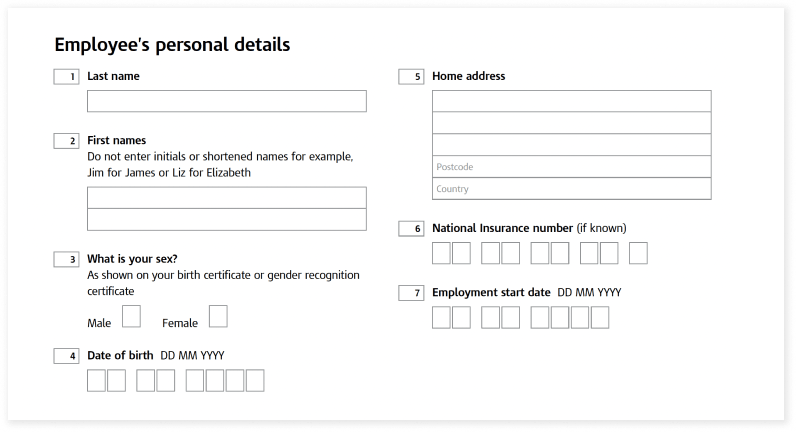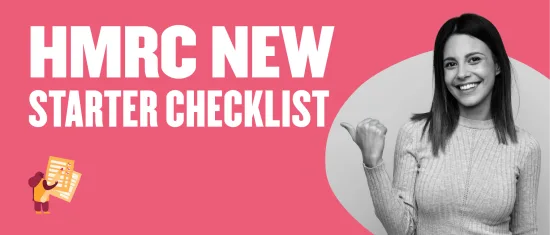Hiring new team members in the United Kingdom? To make sure you have everything you need before the first Full Payment Submission (FPS), use His Majesty’s Revenue & Customs (HMRC) new starter checklist. HMRC uses the new starter form to collect information from new joiners who might not have a P45 form from their previous role.
Below, we’ll explain exactly how it works, when it’s needed, and who needs to do what when it comes to filling it out.
Key insights
- The HMRC new starter checklist is essential for collecting tax information from new joiners in the UK without a P45 form
- It helps determine the correct tax code and student loan deductions to ensure accurate payroll processing
- Employers must use the checklist when there are discrepancies in personal details or when team members are temporarily working in the UK
- HR teams play a pivotal role in guiding new joiners through the checklist, ensuring compliance and efficient onboarding
What is the HMRC new starter checklist?
The HMRC new starter checklist helps employers collect essential tax information about new employees in the UK to determine their tax code and whether or not they receive student loan reductions.
This helps ensure that employees are assigned the correct tax code and pay the correct amount of income tax in their new company.
When do you need a new starter checklist?
You’ll need a new starter checklist if an employee:
- Doesn’t have a P45
- Has personal details that differ from those shown on their P45
- Has been temporarily sent to work in the UK by an employer in another country
Is the new starter checklist the same as a P46 form?
P46 forms are no longer used by HMRC. As an employer in the UK, always use the new starter checklist recommended by HMRC.
Why is the new starter checklist important?
As an employer, you strive to provide your people with the best payroll experience, especially those who have just joined your company. But getting payroll right for new joiners can be tricky, and it can surprise your new starters with unusual tax deductions and raise queries for you on paydays.
Completing the new starter checklist is critical to providing a great payroll experience. Here’s why:
Tax code allocation
Employers rely on the checklist information to match new joiners with the right tax code, ensuring fair and accurate tax deductions right from the start. This helps avoid the need to readjust their paychecks to correct for any over- or underpayments.
Recommended For Further Reading
- Payroll year-end checklists for UK businesses in 2025
- Global payroll systems: Building your multi-national strategy
- The payroll metrics that matter most
- BACS vs Faster Payments
- What is payroll automation?
- Weekly payroll: How it works and top benefits
- Simplify UK payroll with end-to-end HR and payroll software
Avoiding penalties
If you, as an employer, don’t submit accurate information to HMRC, this can result in penalties for both you and your employee(s).
How to help employees complete the HMRC new starter checklist
If your new joiner needs help filling out the HMRC new starter checklist, you can help them with the following:
1. Providing access to the checklist
Share the checklist with team members through HMRC’s website or your payroll software provider.
2. Adding personal details
The form asks for the following personal information, and new joiners may need your help filling out the form accurately:
- Full name, address, and date of birth
- Start date
- National insurance number
- Information on postgraduate or student loans
- Former tax code information
- Details from other income earned in the current tax year from sources like another jobseeker’s allowance, pension, incapacity benefit, etc.
- Passport number if they’re temporarily sent to work in the UK

3. Selecting the right statement
Every employee must declare whether they have another job or are receiving a state, company, or private pension. This declaration helps determine their tax code.
The statement they select impacts the tax code assigned and the taxes they pay. Using the wrong statement means they could end up paying more or less in taxes.
Statement A
Statement A applies to new team members working their first job since April 6 of the current year who have not received a taxable state pension, occupational pension, incapacity benefit, jobseeker’s allowance, or employment and support allowance.
Statement B
Statement B applies to team members who work for only your business but have had another job since April 6 of the current year and don’t have a P45. It also applies if they have received a taxable incapacity benefit, employment and support allowance, or job seekers allowance in the current tax year.
Statement C
Statement C applies if the team member has another job and/or has received a private state or works pension.

4. Completing the student loan declaration
If applicable, make sure people declare their student loan status. This will show whether or not they’re currently repaying a student loan.

How to accurately complete the HMRC new starter checklist as an employer
Once a team member hands in their filled checklist, HR teams finish the process.
1. Determine the NIC category
You’ll need to determine your new team member’s National Insurance Contribution (NIC) category based on their age, earnings, and circumstances.
2. Submit the new starter checklist to HMRC
Once you complete the checklist, submit it to HMRC through your payroll system before the new team member’s first payday. HMRC can add the new person to their system and assign a tax code.
Streamline the new starter checklist process for your team
Streamlining the new starter checklist process supports a smoother onboarding experience for your team. By understanding and utilizing the HMRC new starter checklist, you can accurately manage tax codes, avoid unnecessary delays and penalties, and help new joiners feel welcomed and prepared from day one.
You can always refer to the official HMRC new starter guidelines to ensure compliance and stay up-to-date with the latest requirements.
Meet Bob
Bob simplifies payroll for UK teams with an all-in-one HR and payroll software. Streamline end-to-end payroll for your UK workforce by:
- Centralizing payroll data: Reduce errors and remove the need to update data for your people and payroll operations manually
- Processing payroll in minutes: Cut down on time and automate the end-to-end payroll process without payroll windows or deadlines
- Customizing payroll: Manage diverse payroll needs, including different pay schedules, IR-35 contractors, and flexible employees with varied rates
- Simplifying onboarding and payroll: Provide your people with access to all of their HR and payroll documents in one platform
- Automating payroll calculations: Automate your complex payroll calculations like taxes, deductions, and benefits
- Accessing expert support: Work with our CIPP-certified payroll professionals to ensure you’re running payroll efficiently and accurately
- Managing tax and compliance: Manage tax withholdings, contributions, and reporting, so your businesses will always stay compliant with the latest HMRC laws and regulations
But, that’s not all. Bob’s complete modern HR platform also provides features for:
- Core HR: Leverage this as a foundational hub, offering a social-media-like interface to enhance team engagement.
- People Analytics: Track metrics such as employee turnover and growth rates, aiding in proactive management and cultural alignment.
- Automated onboarding: Use HiBob’s automated onboarding process to ensure a smooth integration of new joiners and align them with the company’s culture from the start
- Time and Attendance: Manage time tracking and attendance efficiently, simplifying payroll processes and ensuring accuracy
- Performance management: Conduct 360-degree reviews and effectively align team member goals with organizational objectives
- Workforce Planning: Use data-driven tools to forecast hiring needs and plan resource allocation strategically
- Surveys: Engage team members through surveys, gathering valuable feedback that informs improvements and measures satisfaction, helping to foster a responsive and inclusive culture
From out-of-the-box onboarding, workflows, performance management, and payroll for UK teams, Bob’s breadth of core HR functionally gives your team everything needed to operate efficiently.
New starter checklist FAQ
Learn more about the new starter checklist:
What is a new starter checklist for?
Use the new starter checklist when someone new joins your business in the UK to determine their tax code.
Does a P45 replace the starter checklist?
A P45 form will typically replace the need for a starter checklist when someone starts a new job in the UK.
People don’t necessarily need a starter checklist if they already have a P45.
When starting a new job, new team members typically provide their new employers with the P45 they received from their previous employer.
The P45 shows people’s earnings and tax payments. Use this to calculate their tax code for their new job at your organization.
If you can’t get all the information you need right away, use a new starter checklist. It will ensure the new joiner’s details are correct to set their tax code.
Is HMRC’s starter checklist a P46?
P46 forms are no longer in use and are not HMRC-compliant. Use the new starter checklist to collect information from new joiners in the UK for tax purposes.
Does a new starter checklist prevent an emergency tax code application?
No, a new starter checklist does not prevent the application of an emergency tax rate. In certain situations, even if someone has completed a starter checklist, an employer may apply an emergency tax code to their salary.
HMRC doesn’t always deliver new employees’ tax information to the employer before a new joiner’s first day. In cases like this, apply an emergency tax code until you receive the correct one from HMRC.
What does an employer do without a new starter checklist?
In the absence of a starter checklist or a P45, place new joiners on starter declaration code C and use tax code 0T.


